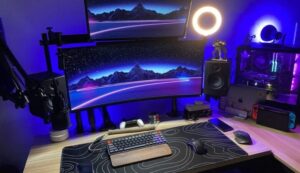
The Intersection of Technology and Space Design
Introduction:
The intersection of technology and space design represents a dynamic and transformative area of modern architecture and interior design. As technological advancements continue to evolve at a rapid pace, their integration into space design has become increasingly sophisticated, leading to innovative approaches that enhance functionality, aesthetics, and user experience. This convergence has reshaped how spaces are conceptualized, developed, and utilized, blending technological solutions with traditional design principles to create environments that are both cutting-edge and comfortable.
In contemporary space design, technology is not merely an add-on but a fundamental component that drives the creation of smarter, more adaptive environments. This integration addresses both practical needs and aesthetic preferences, setting new standards for what is possible in designing spaces for living, working, and leisure.
Smart Technologies Enhancing Interior Environments:
Tal Holtzer, CEO of VPS Server, shares, “The application of smart technologies in interior design has revolutionized how spaces are managed and experienced. Intelligent lighting systems, for instance, can adjust automatically based on time of day, occupancy, or even mood preferences, offering both energy efficiency and personalized comfort. Similarly, climate control systems integrated with IoT (Internet of Things) technology ensure that indoor temperatures remain optimal while reducing energy consumption. These advancements contribute to creating environments that are not only more responsive to the needs of their occupants but also more sustainable.
In addition to functional benefits, smart technologies also introduce a new layer of interaction within interior spaces. Voice-activated assistants and home automation hubs enable users to control various aspects of their environment with simple commands, making everyday tasks more convenient.
Designing Spaces for Mobility and Accessibility with Advanced Technology:
Holly Darani, the Content Head at UNAGI Scooters, shares, “The integration of technology in space design is also significantly enhancing mobility and accessibility. Modern design solutions are focusing on creating environments that accommodate a diverse range of mobility needs, ensuring that spaces are inclusive and accessible to all users. Advanced technologies such as automated door systems, adaptable furniture, and smart navigation aids contribute to a more user-friendly environment, particularly for those with mobility challenges.
By incorporating technology that supports smooth and efficient movement within spaces, designers can create environments that are not only functional but also welcoming and accommodating to everyone. This emphasis on accessibility aligns with the growing recognition of the importance of inclusive design in modern architecture and interior planning.”
The Role of Augmented Reality in Space Planning:
Sai Blackbyrn, CEO at Coach Foundation, shares, “Augmented Reality (AR) has emerged as a powerful tool in space planning and design, offering new ways to visualize and interact with design concepts. By overlaying digital information onto physical spaces, AR enables designers and clients to explore potential layouts, finishes, and furniture arrangements in a more immersive and intuitive manner. This technology facilitates better decision-making by providing a clearer understanding of how different elements will coexist within a space.
Moreover, AR applications in space design extend beyond the initial planning stages. This capability not only enhances the design process but also improves client satisfaction by ensuring that the final result aligns closely with their vision and expectations.”
Creating Productive Work Environments with Technological Integration:
Jon Lynn, founder of My Office Pod, shares, “In the modern work environment, integrating technology plays a critical role in enhancing productivity and creating efficient workspaces. Technology-driven solutions, such as ergonomic office furniture and advanced workspace management systems, contribute significantly to improving comfort and functionality in professional settings. These innovations not only support better work habits but also foster a more engaging and productive atmosphere.
The use of technology in designing workspaces extends beyond just tools and equipment. It encompasses creating environments that adapt to various working styles and needs, from collaborative areas to quiet zones. By incorporating smart solutions that optimize lighting, climate control, and space utilization, modern work environments are becoming more attuned to the demands of today’s workforce, ultimately leading to higher satisfaction and performance.”
The Future of Technology-Driven Space Design:
Leo Baker, Chief Technology Officer at Vendorland, shares, “Looking ahead, the integration of technology into space design is expected to continue evolving, with even more advanced solutions on the horizon. Emerging technologies such as artificial intelligence (AI) and machine learning are likely to further personalize and optimize space design, making it possible to create highly adaptive environments that respond in real-time to changing needs and preferences.
As technology becomes increasingly embedded in our daily lives, the boundaries between digital and physical spaces will continue to blur, leading to new possibilities for space design. The future will likely see more seamless integration of technology, creating spaces that are not only functional and beautiful but also deeply connected to the way people live and work. This ongoing evolution promises to redefine the standards of space design and enhance the overall quality of life.”
The Impact of Sustainable Technologies on Space Design:
John Beebe, CEO and Founder at Classic Car Deals, shares, “Sustainable technology is becoming an essential element in modern space design, driving a shift towards eco-friendly and energy-efficient environments. Innovations such as solar panels, energy-efficient HVAC systems, and sustainable building materials are not only reducing the environmental footprint of buildings but also contributing to healthier and more sustainable living and working conditions. This trend highlights the importance of incorporating environmentally responsible practices into design, reflecting a broader commitment to creating spaces that benefit both people and the planet.”
Conclusion:
The intersection of technology and space design represents a transformative shift in how environments are created and experienced. The integration of smart technologies, augmented reality, and innovative materials has redefined the possibilities within space design, leading to more functional, aesthetically pleasing, and sustainable environments. As technology continues to advance, its role in shaping spaces will only become more integral, promising exciting developments for the future of design.



Average Rating